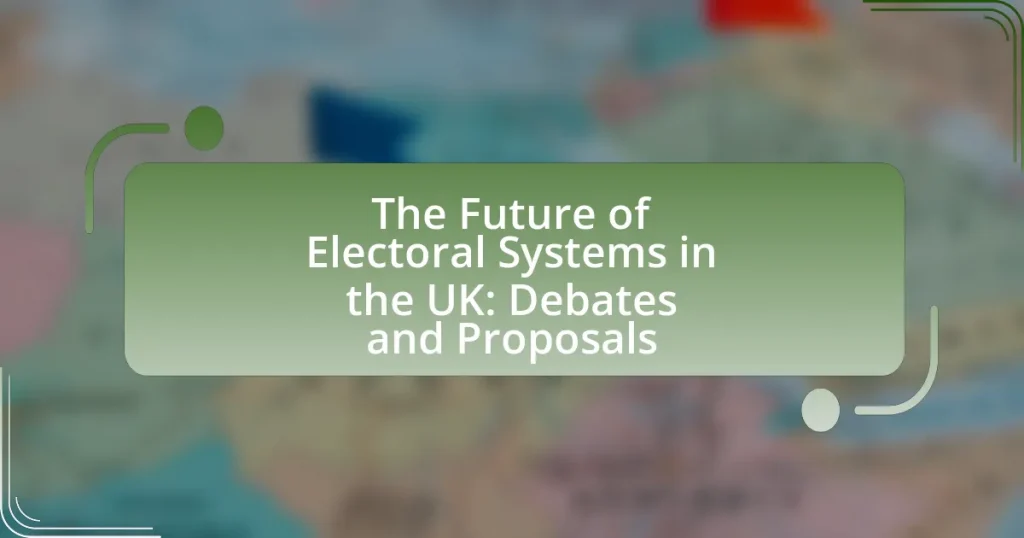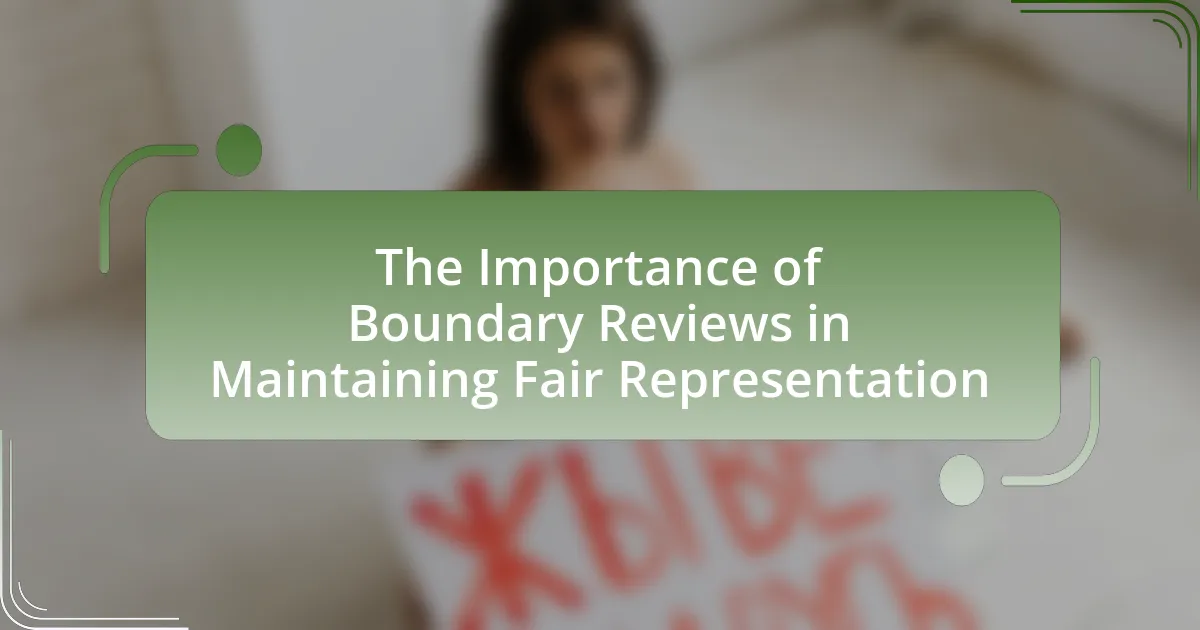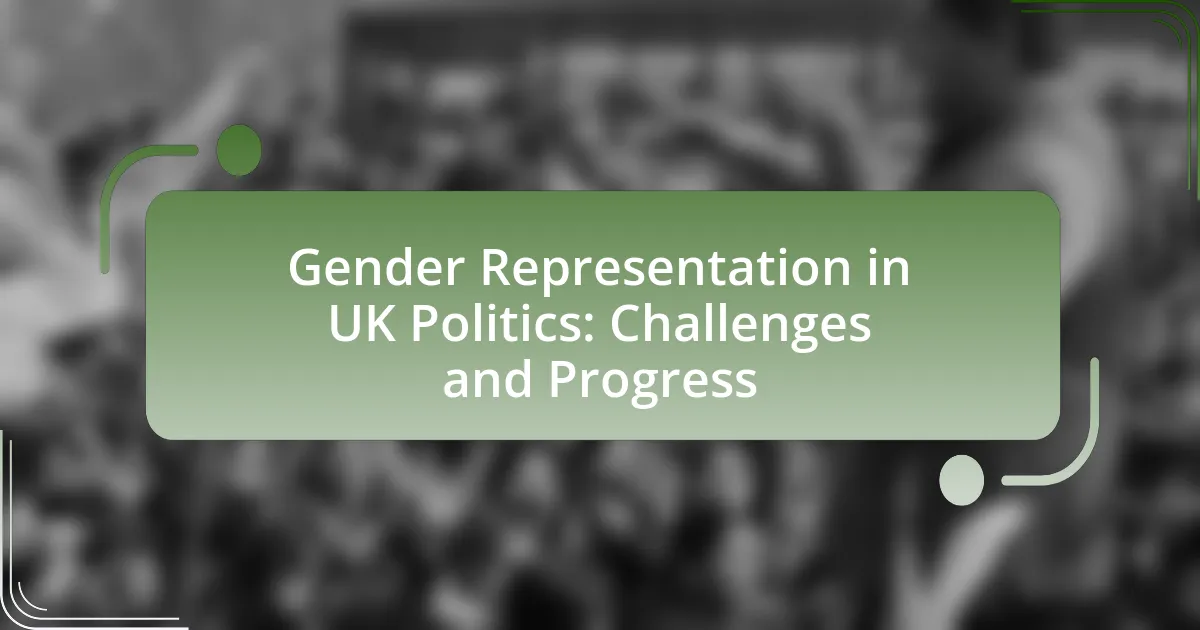The article examines the current electoral systems in the UK, highlighting the First Past the Post system used for general elections, as well as alternative systems like the Additional Member System, Single Transferable Vote, and Alternative Vote. It discusses how these systems function in practice, their historical contexts, and the ongoing debates surrounding electoral reform. Key arguments for and against changing the current system are presented, along with proposals for reform, including proportional representation and ranked-choice voting. The article also explores the potential impacts of these reforms on voter engagement, party dynamics, and overall representation in UK politics.
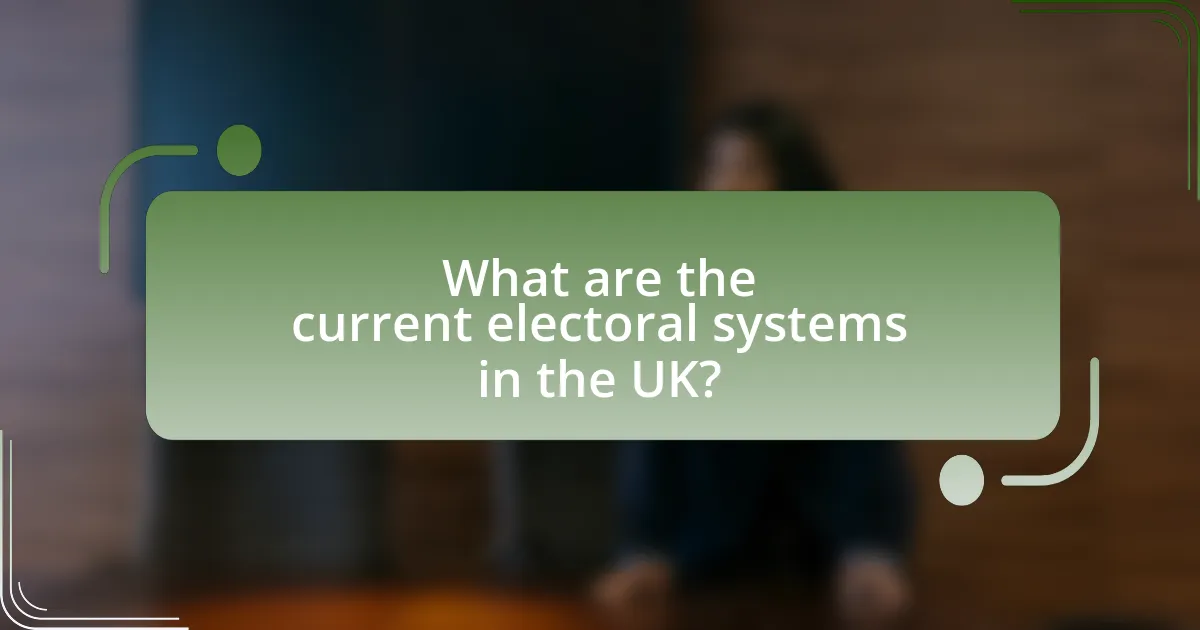
What are the current electoral systems in the UK?
The current electoral systems in the UK include First Past the Post for general elections, the Additional Member System for the Scottish Parliament and Welsh Assembly, the Single Transferable Vote for local elections in Scotland and Northern Ireland Assembly elections, and the Alternative Vote for some local elections in England. First Past the Post is characterized by the candidate with the most votes winning in each constituency, while the Additional Member System combines proportional representation with constituency-based representation. The Single Transferable Vote allows voters to rank candidates, promoting proportionality, and the Alternative Vote enables voters to rank candidates in order of preference. These systems reflect a mix of majoritarian and proportional approaches to electoral representation in the UK.
How do these systems function in practice?
Electoral systems function in practice by translating votes into seats in a legislative body, with various methods determining how this conversion occurs. For instance, the First-Past-the-Post system awards seats to candidates who receive the most votes in their constituencies, often leading to a disparity between the percentage of votes received and the percentage of seats won. In contrast, proportional representation systems, such as the Single Transferable Vote, allocate seats based on the overall share of votes each party receives, promoting a more equitable representation of diverse political views. Evidence from countries using these systems, such as Germany and New Zealand, demonstrates that proportional representation can lead to coalition governments, reflecting a broader spectrum of voter preferences and enhancing political stability.
What are the key features of the First Past the Post system?
The First Past the Post (FPTP) system is characterized by its simplicity, where the candidate with the most votes in a constituency wins, regardless of whether they achieve an absolute majority. This electoral method is widely used in the UK for general elections, allowing voters to select one candidate on the ballot. The system often leads to a quick resolution of election outcomes, as counting votes is straightforward and results are typically available soon after polls close. Additionally, FPTP tends to favor larger political parties, often resulting in a disproportionate representation where the number of seats won does not reflect the overall share of votes received. Historical data shows that in the 2019 UK general election, the Conservative Party won 365 seats with only 43.6% of the popular vote, illustrating this feature of the system.
How does the Alternative Vote system differ from First Past the Post?
The Alternative Vote (AV) system differs from First Past the Post (FPTP) in that AV allows voters to rank candidates in order of preference, while FPTP requires voters to select only one candidate. In AV, if no candidate receives an outright majority of first-choice votes, the candidate with the fewest votes is eliminated, and their votes are redistributed based on the voters’ next preferences until a candidate achieves a majority. This contrasts with FPTP, where the candidate with the most votes wins, regardless of whether they achieve a majority. The AV system aims to ensure that elected representatives have broader support among the electorate, addressing the potential for “wasted” votes that can occur in FPTP.
What are the historical contexts of these electoral systems?
Electoral systems in the UK have evolved through significant historical contexts, primarily influenced by political, social, and economic changes. The first-past-the-post system, established in the 19th century, emerged from the need for a straightforward method to elect representatives in a growing parliamentary democracy. This system was solidified by the Representation of the People Acts, particularly in 1918, which expanded suffrage to include all men and women over 30, reflecting the changing societal norms and the push for greater representation.
The introduction of proportional representation in certain contexts, such as the Scottish Parliament and the Welsh Assembly, arose from demands for more equitable representation, particularly after the devolution movements of the late 20th century. These movements were driven by regional identities and the desire for local governance, highlighting the historical context of nationalism and regional autonomy within the UK.
Additionally, the debates surrounding electoral reform in the 21st century, including the 2011 Alternative Vote referendum, reflect ongoing tensions between traditional practices and modern democratic ideals. These discussions are rooted in historical grievances about representation and fairness, showcasing the dynamic nature of electoral systems in response to societal changes.
How have electoral systems evolved in the UK over time?
Electoral systems in the UK have evolved significantly from the early 19th century to the present day. Initially, the UK employed a system of plural voting and limited suffrage, where only property-owning men could vote. The Reform Acts of 1832, 1867, and 1884 progressively expanded the electorate by lowering property requirements and granting voting rights to more men, culminating in universal male suffrage by 1918. The Representation of the People Act 1928 further extended voting rights to women, achieving equal suffrage.
In terms of electoral systems, the UK primarily uses the First Past the Post (FPTP) system for general elections, which has been in place since the 19th century. However, the late 20th century saw the introduction of alternative voting systems in devolved administrations, such as the Additional Member System (AMS) in Scotland and the Single Transferable Vote (STV) in Northern Ireland, reflecting a shift towards proportional representation.
These changes illustrate a gradual move towards inclusivity and representation in the electoral process, driven by social and political movements advocating for broader democratic participation.
What major reforms have been proposed in the past?
Major reforms proposed in the past regarding electoral systems in the UK include the introduction of proportional representation, the Alternative Vote system, and the implementation of the Single Transferable Vote. Proportional representation has been advocated to ensure that the number of seats won by a party reflects its share of the vote, addressing concerns about the disproportionality of the First Past the Post system. The Alternative Vote system was proposed to allow voters to rank candidates in order of preference, which could lead to more representative outcomes. The Single Transferable Vote has been suggested for multi-member constituencies, aiming to enhance voter choice and representation. These proposals have been discussed in various reports and debates, including the Jenkins Report in 1998, which recommended a form of proportional representation for the House of Commons.
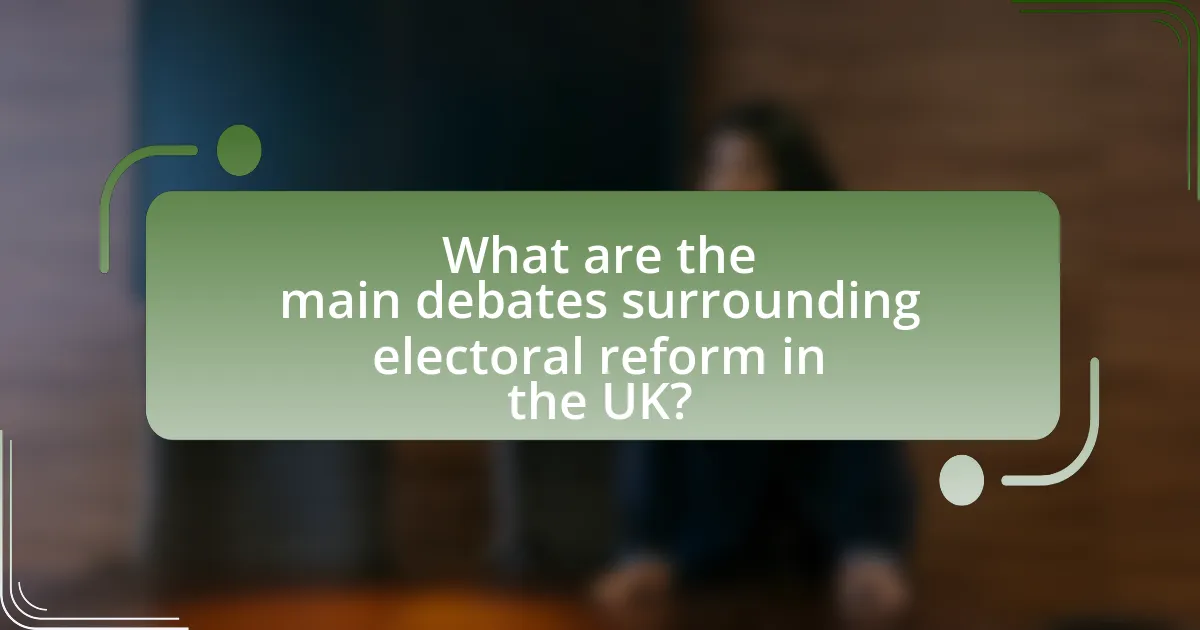
What are the main debates surrounding electoral reform in the UK?
The main debates surrounding electoral reform in the UK focus on the effectiveness of the current First Past the Post (FPTP) system versus alternative voting methods, such as proportional representation (PR). Advocates for reform argue that FPTP leads to disproportionate representation, where smaller parties struggle to gain seats despite significant public support, as evidenced by the 2019 general election where the Liberal Democrats received 11.5% of the vote but only secured 1.7% of the seats. Conversely, opponents of reform contend that FPTP provides stable governments and clear outcomes, citing historical instances where PR has led to fragmented parliaments and coalition governments, which can complicate governance. Additionally, debates include the potential impact of reform on voter engagement and the legitimacy of elected representatives, with studies indicating that more proportional systems may enhance voter satisfaction and participation.
Why is there a push for electoral reform now?
There is a push for electoral reform now due to increasing public dissatisfaction with the current electoral system, particularly the First Past the Post system, which many believe leads to unrepresentative outcomes. Recent elections have highlighted issues such as wasted votes and disproportionate representation, prompting calls for change. For instance, in the 2019 general election, the Conservative Party won 365 seats with only 43.6% of the popular vote, illustrating the system’s flaws. Additionally, movements advocating for proportional representation have gained momentum, supported by various surveys indicating that a significant portion of the electorate favors reform to ensure fairer representation.
What factors are driving public interest in changing the electoral system?
Public interest in changing the electoral system is primarily driven by perceptions of fairness, representation, and dissatisfaction with the current system. Many citizens believe that the existing first-past-the-post system leads to disproportionate representation, where votes do not translate into seats effectively, resulting in a lack of diverse political voices in Parliament. For instance, the 2019 general election in the UK saw the Conservative Party win 365 seats with only 43.6% of the popular vote, highlighting this disparity. Additionally, movements advocating for proportional representation have gained traction, as they argue that such systems can better reflect the electorate’s preferences and enhance democratic legitimacy. The growing awareness of these issues, coupled with calls for reform from various political and civic organizations, has intensified public discourse around the need for electoral system change.
How do political parties view electoral reform?
Political parties in the UK have varied views on electoral reform, often influenced by their ideological positions and electoral strategies. For instance, the Labour Party generally supports proportional representation, arguing it would lead to a fairer reflection of voter preferences, as evidenced by their 2019 manifesto which advocated for a review of the electoral system. Conversely, the Conservative Party tends to favor the current first-past-the-post system, citing its stability and simplicity, which they believe benefits the governance process. The Liberal Democrats advocate for a switch to a proportional system, emphasizing that it would enhance democratic engagement and representation, a stance they have consistently maintained since their formation. These differing perspectives illustrate the complex landscape of electoral reform debates among UK political parties.
What are the arguments for and against changing the current system?
Arguments for changing the current electoral system in the UK include the potential for increased voter representation and fairness. Proponents argue that systems like proportional representation could better reflect the diverse political views of the electorate, as evidenced by the 2019 general election where the Conservative Party won a significant majority with only 43.6% of the popular vote. This disparity highlights the limitations of the first-past-the-post system, which can lead to wasted votes and underrepresentation of smaller parties.
Conversely, arguments against changing the current system emphasize its simplicity and stability. Critics argue that the first-past-the-post system provides clear outcomes and a strong link between constituents and their representatives, which can foster accountability. Historical data shows that countries with proportional representation often experience fragmented parliaments and coalition governments, which can lead to political instability and indecision.
What benefits do proponents of reform argue for?
Proponents of reform argue that electoral system changes can lead to increased voter representation and engagement. They assert that reforms, such as proportional representation, can better reflect the diverse political views of the electorate, resulting in a more accurate representation of public opinion in legislative bodies. Evidence from countries that have adopted such systems shows higher voter turnout and satisfaction, indicating that when citizens feel their votes matter, they are more likely to participate in elections. Additionally, proponents claim that reforms can reduce the dominance of major parties, fostering a more competitive political environment that encourages new voices and ideas.
What concerns do opponents of reform raise?
Opponents of reform raise concerns about the potential for increased political instability and the undermining of traditional party structures. They argue that changes to electoral systems, such as moving to proportional representation, could lead to fragmented parliaments and coalition governments that may struggle to achieve decisive governance. Historical examples, such as the experience of countries like Italy and Israel, illustrate how proportional systems can result in frequent elections and unstable governments, which opponents cite as a risk for the UK. Additionally, critics express worries that reforms may dilute the accountability of elected representatives, making it harder for voters to hold parties responsible for their actions.
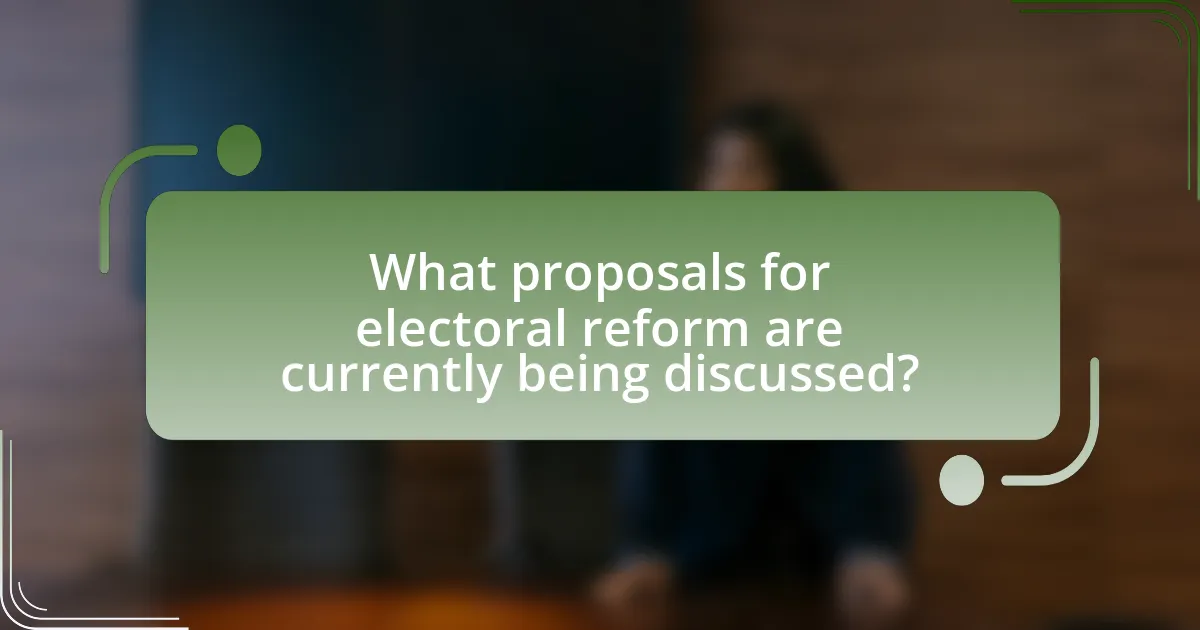
What proposals for electoral reform are currently being discussed?
Proposals for electoral reform currently being discussed in the UK include the introduction of proportional representation, the implementation of ranked-choice voting, and the establishment of a citizens’ assembly to review electoral processes. Proportional representation aims to ensure that the number of seats held by a party reflects the percentage of votes they receive, addressing concerns about the disproportionality of the current first-past-the-post system. Ranked-choice voting allows voters to rank candidates in order of preference, which can lead to more representative outcomes and reduce the impact of tactical voting. Additionally, the idea of a citizens’ assembly seeks to involve a diverse group of citizens in evaluating and recommending changes to the electoral system, promoting democratic engagement and legitimacy in the reform process. These discussions are part of a broader debate on how to enhance the fairness and effectiveness of the UK’s electoral system.
What alternative electoral systems are being considered?
Alternative electoral systems being considered in the UK include proportional representation, ranked choice voting, and the single transferable vote. Proportional representation aims to allocate seats in Parliament based on the percentage of votes each party receives, which contrasts with the current first-past-the-post system. Ranked choice voting allows voters to rank candidates in order of preference, ensuring that the winning candidate has broader support. The single transferable vote is a form of proportional representation that enables voters to express preferences for multiple candidates, facilitating a more representative outcome. These systems are being debated as potential reforms to enhance democratic representation and address concerns about voter disenfranchisement.
How does the Single Transferable Vote system work?
The Single Transferable Vote (STV) system works by allowing voters to rank candidates in order of preference, ensuring that votes are transferred according to these preferences until all available seats are filled. In STV, each voter casts a single vote that can be allocated to their preferred candidate, and if that candidate has enough votes to meet a predetermined quota, any excess votes are transferred to the next preferred candidate on the voter’s list. This process continues until all seats are filled, promoting proportional representation and reducing wasted votes. The effectiveness of STV is evidenced by its use in various elections, such as those in Ireland and Australia, where it has been shown to enhance voter satisfaction and representation.
What is the concept of proportional representation?
Proportional representation is an electoral system in which parties gain seats in the legislature in proportion to the number of votes they receive. This system contrasts with winner-takes-all approaches, ensuring that smaller parties have a fair chance of representation. For example, in countries like Sweden and New Zealand, proportional representation has led to a more diverse political landscape, allowing for coalition governments that reflect a broader spectrum of voter preferences. Studies show that proportional representation can enhance voter turnout and engagement, as individuals feel their votes carry more weight in influencing legislative outcomes.
What are the potential impacts of these proposals on UK politics?
The potential impacts of electoral system proposals on UK politics include increased representation, shifts in party dynamics, and changes in voter engagement. Implementing proportional representation could lead to a more diverse parliament, reflecting a broader spectrum of public opinion, as evidenced by countries like Germany, where such systems have resulted in multi-party coalitions. Additionally, these proposals may disrupt traditional party strongholds, as seen in the 2019 general election, where smaller parties gained significant ground. Enhanced voter engagement is also likely, as more citizens may feel their votes carry weight in a proportional system, similar to trends observed in countries that have adopted similar reforms.
How might electoral reform affect voter engagement and turnout?
Electoral reform can significantly enhance voter engagement and turnout by making the voting process more accessible and representative. For instance, implementing proportional representation systems has been shown to increase voter participation, as evidenced by countries like Germany, where turnout rates are consistently higher than in the UK. Additionally, reforms such as automatic voter registration and extended voting periods can reduce barriers to participation, leading to increased engagement. Studies indicate that when voters feel their votes carry more weight in a proportional system, they are more likely to participate in elections, as seen in the 2019 European Parliament elections in the UK, where turnout was notably higher in regions with more representative electoral systems.
What changes could occur in party dynamics and representation?
Changes in party dynamics and representation could include increased fragmentation of political parties and a shift towards more proportional representation. As electoral systems evolve, such as through the adoption of ranked-choice voting or proportional representation, smaller parties may gain more seats, leading to a multiparty system. Historical examples, like the introduction of proportional representation in countries such as Germany, demonstrate that these systems can enhance the representation of diverse political views, resulting in coalition governments. This shift can alter traditional party hierarchies and necessitate new strategies for collaboration among parties, ultimately reshaping the political landscape.
What practical steps can be taken to advocate for electoral reform?
To advocate for electoral reform, individuals and organizations can engage in grassroots campaigning, which includes organizing community meetings to raise awareness about the need for change. This approach has been effective in various movements, such as the campaign for the Alternative Vote in the UK, which mobilized public support through local discussions and events. Additionally, forming coalitions with like-minded groups can amplify the message and increase pressure on policymakers. Research indicates that collaborative efforts can lead to more significant political influence, as seen in successful reform initiatives in other countries. Furthermore, utilizing social media platforms to disseminate information and gather support can enhance visibility and engagement, as demonstrated by the effectiveness of online campaigns in recent electoral movements.
How can citizens get involved in the electoral reform movement?
Citizens can get involved in the electoral reform movement by participating in advocacy groups, attending public forums, and engaging in grassroots campaigns. Advocacy groups such as the Electoral Reform Society actively seek public support and provide resources for citizens to understand and promote electoral changes. Public forums often allow citizens to voice their opinions and learn about proposed reforms, fostering community engagement. Grassroots campaigns enable individuals to mobilize support for specific reforms, such as proportional representation, which has been shown to increase voter engagement and representation in countries like Germany and New Zealand.
What resources are available for those interested in learning more about electoral systems?
Resources available for those interested in learning more about electoral systems include academic journals, books, online courses, and government publications. Academic journals such as the Electoral Studies journal provide peer-reviewed articles on various electoral systems and their impacts. Books like “Electoral Systems: A Comparative Introduction” by David M. Farrell offer comprehensive insights into different electoral frameworks. Online platforms like Coursera and edX feature courses on political science that cover electoral systems in depth. Additionally, government publications, such as reports from the UK Electoral Commission, provide official data and analysis on electoral processes in the UK. These resources collectively enhance understanding of electoral systems and their implications.
